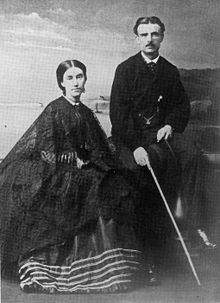Frederick Broome
|
Sir Frederick Broome KCMG |
|
|---|---|

Frederick Broome with his wife, Mary Anne Barker; circa 1866
|
|
| Governor of Trinidad and Tobago | |
|
In office 1891–1897 |
|
| Monarch | Victoria |
| Preceded by | Sir William Robinson |
| Succeeded by | Sir Hubert Jerningham |
| Governor of Western Australia | |
|
In office 1883–1889 |
|
| Monarch | Victoria |
| Preceded by | Sir William Robinson |
| Succeeded by | Sir William Robinson |
| Governor of Mauritius | |
|
In office 1880–1883 |
|
| Monarch | Victoria |
| Preceded by | Sir George Bowen |
| Succeeded by | Sir John Pope Hennessy |
| Personal details | |
| Born | 18 November 1842 Canada |
| Died | 1896 London, England |
Sir Frederick Napier Broome KCMG (18 November 1842–1896) was a colonial administrator in the British Empire, serving in Natal, Mauritius, Western Australia, Barbados and Trinidad. The Western Australian towns of Broome and Broomehill are named after him.
The eldest son of Rev. Frederick Broome, rector of Kenley, Shropshire, by his wife Catherine Eleanor (eldest daughter of Lieut.-Colonel Napier, formerly Superintendent, Indian Department, Canada) Broome was born in Canada and educated at Whitchurch Grammar School, Shropshire. When visiting England in 1865, he married Mary Anne Barker on 21 June. The couple moved to New Zealand where Broome had a sheep station, in the Malvern Hills, province of Canterbury.
Broome returned to London in 1869, and for the following six years was a regular contributor to The Times, being the newspaper's correspondent at the Duke of Edinburgh's marriage at St. Petersburg, and on many other occasions. He also wrote literary reviews, art critiques, and miscellaneous articles. He published two volumes of verse, Poems from New Zealand (1868) and The Stranger of Seriphos (1869), and contributed verse to the Cornhill, Macmillan's Magazine, and other periodicals.
In 1870 he was appointed secretary to the St. Paul's Cathedral Completion Fund, and, in 1873, secretary to the Royal Commission on Unseaworthy Ships, and held for some time a commission in the Essex yeomanry. He was selected by the Earl of Carnarvon, in 1875, to proceed with Lord Garnet Wolseley on a special mission to Natal, as colonial secretary of that colony. He held that post until 1878, when he was promoted to the colonial secretaryship of Mauritius, where he administered the government in 1879, and was lieutenant-governor of the island from 1880 to 1888. He was the 14th governor of Mauritius from 9 Dec 1880 to 5 May 1883. He was created CMG in 1877, and KCMG in 1884
...
Wikipedia
